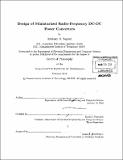Design of miniaturized radio-frequency DC-DC power converters
Author(s)
Sagneri, Anthony (Anthony David)
DownloadFull printable version (32.33Mb)
Other Contributors
Massachusetts Institute of Technology. Dept. of Electrical Engineering and Computer Science.
Advisor
David J. Perreault.
Terms of use
Metadata
Show full item recordAbstract
Power electronics appear in nearly every piece of modern electronic hardware, forming an essential conduit from electrical source to load. Portable electronics, an area where a premium is placed on size, weight, and cost, are driving the development of power systems with greater density and better manufacturability. This motivates a push to higher switching frequencies enabling smaller passive components and better integration. To realize these goals this thesis explores devices, circuits, and passives capable of operating efficiently into the VHF regime (30-300 MHz) and their integration into power electronic systems of high power density. A good integrated power MOSFET presages high-density converters. Previous VHF systems were demonstrated with bulky and expensive RF Lateral, Double-Diffused MOSFETs (LDMOSFET). We show that through a combination of layout optimization and safe operating area (SOA) extension integrated devices can achieve near-parity performance to their purpose-built RF discrete cousins over the desired operating regime. A layout optimization method demonstrating a 2x reduction in device loss is presented alongside experimental demonstration of SOA extension. Together the methods yield a 3x reduction in loss that bolsters the utility of the typical (and relatively inexpensive) LDMOS IC power process for VHF converters. Passive component synthesis is addressed in the context of an isolated VHF converter topology. We present a VHF topology where most of the magnetic energy storage is accomplished in a transformer that forms an essential part of the resonant network. The reduced component count aids in manufacturability and size, but places difficult requirements on the transformer design. An algorithm for synthesizing small and efficient air-core transformers with a fully-constrained inductance matrix is presented. Planar PCB transformers are fabricated and match the the design specifications to within 15%. They are 94% efficient and have a power density greater than 2kW per cubic inch. To take full advantage of good devices and printed passives, we develop an IC for the isolated converter having optimized power devices, and integrated gate driver, controller, and hotel functions. The chip is assembled into a complete converter system using the transformers and circuits described above. Flip-chip mounting is used to overcome bondwire parasitics, and reduce packaging volume. The final system achieves 75% efficiency at 75 MHz at 6W.
Description
Thesis (Ph. D.)--Massachusetts Institute of Technology, Dept. of Electrical Engineering and Computer Science, 2012. Cataloged from PDF version of thesis. Includes bibliographical references (p. 321-325).
Date issued
2012Department
Massachusetts Institute of Technology. Department of Electrical Engineering and Computer SciencePublisher
Massachusetts Institute of Technology
Keywords
Electrical Engineering and Computer Science.